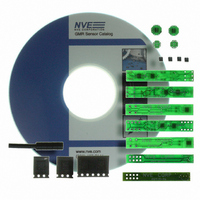AG920-07E NVE, AG920-07E Datasheet - Page 9

AG920-07E
Manufacturer Part Number
AG920-07E
Description
KIT EVALUATION GT SENSOR
Manufacturer
NVE
Specifications of AG920-07E
Sensor Type
Magnetic. GMR (Giant Magnetoresistive)
Interface
Analog
Embedded
No
Utilized Ic / Part
ABL & AKL Series GT Sensors
Lead Free Status / RoHS Status
Lead free / RoHS Compliant
Voltage - Supply
-
Sensitivity
-
Sensing Range
-
Other names
391-1063
- Current page: 9 of 143
- Download datasheet (2Mb)
Gradiometers
NVE’s gradiometers, or differential sensors, rely on the field gradient across the IC to generate an
output. In fact, if one of these sensors is placed in a uniform magnetic field, its output voltage will be
zero. This is because all four of the bridge resistors are exposed to the same magnetic field, so they all
change resistance together. There is no shielding or flux concentration on a gradiometer. A simple
representation of a gradiometer is shown in the diagram below:
Because all four bridge resistors contribute to the sensor’s output, at maximum differential field NVE’s
gradiometers can provide double the output signal of our magnetometer parts—approximately 700 mV
with a 5V supply. In practice, the gradient fields are typically not high enough to give this maximum
signal, but signal levels of 50 mV to 200 mV are common.
NVE’s GMR differential sensors are typically designed with two of the bridge resistors at one end of
the IC, and two at the other end. The spacing between the two sets of resistors, combined with the
magnetic field gradient on the IC, will determine the output signal from the sensor element. NVE
offers three standard spacings for differential sensors: 0.3 mm, 0.5 mm, and 1.0 mm. If a different
spacing is desired, contact NVE for development cost and schedule for a custom product.
The most popular application for differential sensors is in gear tooth or magnetic encoder detection. As
these structures move or spin the magnetic field near their surface is constantly varying, generating a
field gradient. A differential sensor, properly placed, can detect this movement by sensing the
changing field gradient and provide an output for each gear tooth or each magnetic pole (see the GT
Sensor section of this catalog for a more detailed explanation). Applications for these devices include
detecting the speed and position of electric motor shafts or bearings, automotive transmission gear
speeds, axle shaft speed in Anti-lock Braking Systems (ABS), or linear gear-tooth position.
R3
R4
(Differential Sensor)
Gradiometer
www.nve.com
phone: 952-829-9217 fax: 952-829-9189
R1
R2
- 9 -
Out-
R4
R2
Introduction
R1
R3
Out+
Related parts for AG920-07E
Image
Part Number
Description
Manufacturer
Datasheet
Request
R

Part Number:
Description:
KIT EVALUATION GT SENSOR
Manufacturer:
NVE
Datasheet:

Part Number:
Description:
ISOLATOR HS MAG DIGITAL 8SOIC
Manufacturer:
NVE
Datasheet:

Part Number:
Description:
ISOLATOR HS DIGITAL 125C 8SOIC
Manufacturer:
NVE
Datasheet:

Part Number:
Description:
HI-SPD 4CHANN COUPLER 16-SOIC LF
Manufacturer:
NVE
Datasheet:

Part Number:
Description:
ISOLATOR HS MAG DIGITAL 16SOIC
Manufacturer:
NVE
Datasheet:

Part Number:
Description:
ISOLATOR HS MAG DIGITAL 8SOIC
Manufacturer:
NVE
Datasheet:

Part Number:
Description:
IC DIFFER BUS TRANSC 16 SOIC
Manufacturer:
NVE
Datasheet:

Part Number:
Description:
ISOLATOR HS MAG DIGITAL 16SOICW
Manufacturer:
NVE
Datasheet:

Part Number:
Description:
ISOLATOR RS422/485 INTFC 16SOICW
Manufacturer:
NVE
Datasheet:

Part Number:
Description:
ISOLATOR HS MAG DIGITAL 16SOICW
Manufacturer:
NVE
Datasheet:

Part Number:
Description:
IC, DIGITAL ISOLATOR, 12NS, NSOIC-8
Manufacturer:
NVE
Datasheet:

Part Number:
Description:
IC, DIGITAL ISOLATOR, 12NS, DIP-8
Manufacturer:
NVE
Datasheet:

Part Number:
Description:
IC TXRX ISOLATED CAN HS 16SOIC
Manufacturer:
NVE
Datasheet:










